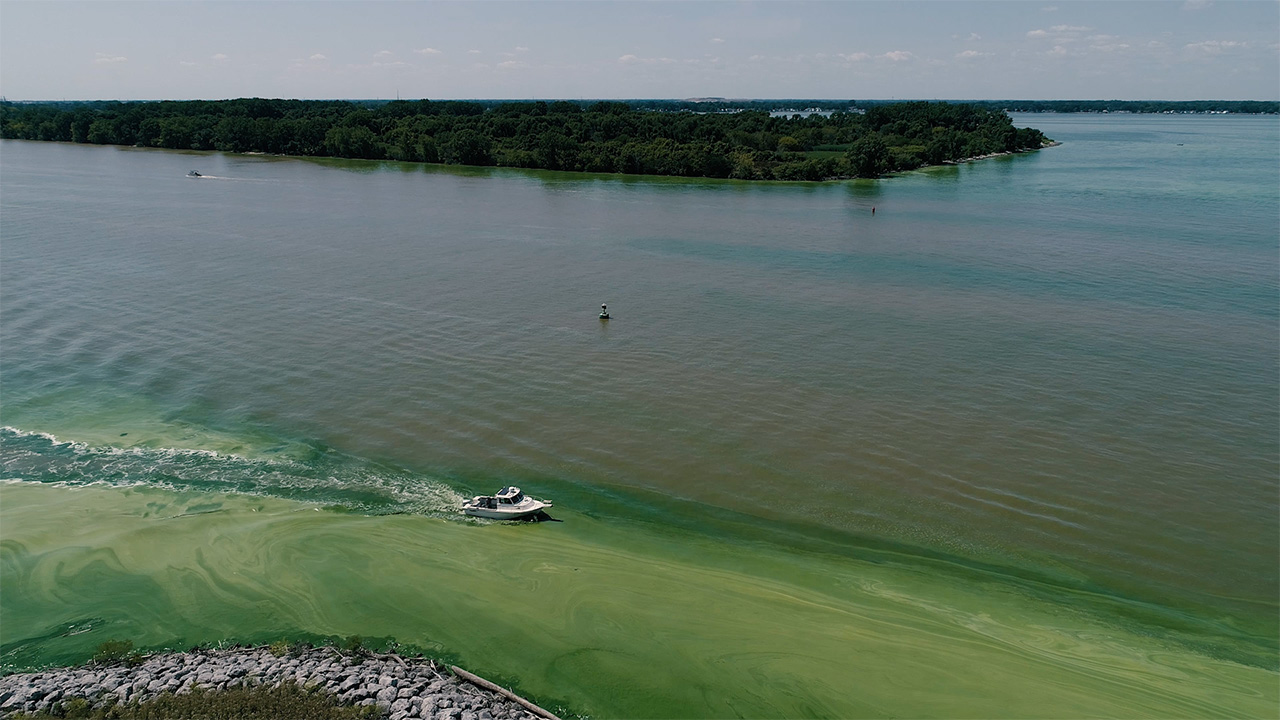
For the second year in a row, scientists predict the annual Lake Erie cyanobacteria bloom will be smaller than it has been in the past decade.
The National Oceanic and Atmospheric Administration’s forecast, assembled with the help of multiple partners, indicates an expected bloom severity index of 3 on a scale of 10.5.
“For the first time in a decade, we’re looking at two consecutive years with a relatively mild bloom,” said Rick Stumpf, NOAA oceanographer at the National Center for Coastal Ocean Science. “The severity forecast is 3, with 2 to 4.5 the likely range. I can’t emphasize enough that most of the lake will be fine most of the time.”
Unfortunately, Stumpf said, the low prediction numbers are really more the result of low water flow on the Maumee River and not from reduction of nutrients entering the lake.
While Lake Erie has been vexed with harmful algal blooms for decades, it wasn’t until the Toledo water crisis in 2014 when drinking water for the entire city was shut down that it started receiving high priority.
The bloom forecast was announced at a live web event June 30 attended by more than 120.
Ohio Reps. Marcy Kaptur and Bob Latta both offered brief remarks via pre-recorded video praising those who have been working to solve Lake Erie’s algae issues and promising future support.
Lucky weather or changing habits?
“I think it’s great news, because farmers watch these numbers as much as the general public because they want to know if what they’re doing is working,” said Ty Higgins, spokesman for the Ohio Farm Bureau. “They want to see if this mild bloom comes to fruition at the end of the year, this would be four of the last six years we’ve had a bloom under 4, and that’s a very positive thing.”
Higgins said he believes the Ohio laws regulating food growers and their operations that have been in place for more than a decade now have made a difference. In addition, he said, voluntary measures farmers have taken, such as extensive use of cover crops, filter strips and other best management practices are beginning to produce results.
But Laura Johnson, director at Heidelberg University’s National Center for Water Quality Research, cited precipitation – or lack of it this spring – as a main driver in the low prediction number. Low precipitation amounts resulted in less water entering Lake Erie from the Maumee River watershed, 5,000 square miles in 18 northwest Ohio counties, and one of the main sources of Lake Erie’s excessive nutrient loading. The watershed has a particularly high concentration of concentrated animal feeding operations.
“It’s been a pretty dry year,” she said. “We haven’t had flow this low since 2012.”
According to Johnson, phosphorous concentration from fertilizer and manure in the Maumee River is still above the target scientists are aiming for and is lingering around the same annual averages it has in recent years. However, the low flow of water has mitigated that fact, resulting in the mild algal bloom prediction this year.
Smaller blooms don’t necessarily mean less toxins
Even though a particular bloom may produce massive amounts of cyanobacteria, a type of blue-green algae, it may or may not produce significant amounts of microcystin, the toxin which can cause health problems in people and pets.
“You can’t just simply judge if it’s toxic or not based on how much green there is,” explained Justin Chaffin, research coordinator at Ohio State University’s Stone Lab. “There’s no relation between biomass and toxins.”
Chaffin said that in two consecutive years, nearly 20 research partners spread out across the Western Basin during a one day “HAB grab” in which water samples were taken simultaneously at up to 100 locations during a peak bloom.
Scientists working on the toxin issue say they’ve found a tentative link between nitrogen levels in blooms and toxicity.
“Bloom boundaries pose challenges as microcystin concentrations can rapidly change over short distances,” Chaffin said.
NOAA uses high-quality satellite imagery from European Union satellites to track algae blooms each season. The public can access the up-to-the hour data and imagery on NOAA’s forecast website. Chaffin said scientists have yet to figure out how to track toxicity utilizing satellites.
Good news for fishing
“This is icing on the cake,” said Paul Pacholski, president of the Lake Erie Charter Boat Association, citing both great walleye fishing on Lake Erie and the apparent subsiding of the COVID-19 pandemic. “Anytime we have a light algae bloom, it’s good for business. I think it’s really going to be a great year. If we can avoid the stigma of microcystis this year, I think it will bode well for the next five to 10 years.”
He said algal bloom severity is tied directly to bookings for Lake Erie’s 700-plus charter captains.
“As soon as they make the announcement we are having a severe algae bloom, the phone stops ringing, and if it does ring it’s going the other way,” Pacholski said, referring to cancellations. “’Maybe we’ll come back in the fall or swing by earlier next year,’ people say.”
Lake Erie Shores and Islands Executive Director Larry Fletcher said he’s definitely glad to see the bloom severity forecast on the low side, though he still sees possible challenges in the far western end of the lake.
“That doesn’t mean the concentration of toxin is necessarily less,” he pointed out, going on to say we can’t always depend on nature to mitigate the algae issue with less-than-average precipitation.
Fletcher said that media coverage during years when a severe bloom occurs dampens tourist enthusiasm. He also said that conversely, when there isn’t a severe bloom that people are reading about in the news, that impacts whether people from other parts of Ohio and in other states will visit as well.
Fletcher said bad blooms spawn phone calls to hotels, attractions and the Shores and Islands visitor centers. He echoed Stumpf’s sentiment about the lake as a whole during years when severe blooms occur, saying that even in the most severe years most of the lake is still in good shape.
“There isn’t a bloom on the entire lake – there’s still plenty of places to get out and enjoy the water,” Fletcher said.
Catch more news on Great Lakes Now:
Toxic Algae 2020: Moderate bloom forecasted for Lake Erie
Marine Blooms of Harmful Algae Increasing in Europe, Much of the Americas
Algae may vacuum microplastics, but also indicates greater health threat
API key not valid. Please pass a valid API key.Featured image: Harmful algal bloom in western Lake Erie (Great Lakes Now Episode 1013)
1 Comment
-
Lake Erie is better? High E. Coli levels at many Ohio beaches and now the algae bloom has moved in. That’s how the summer has been here in Huron, Ohio. Maybe it’s time for a follow up story.




